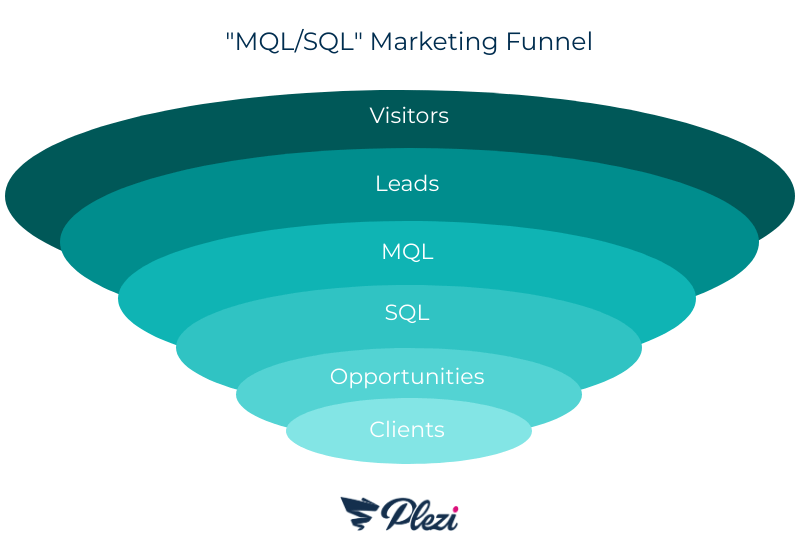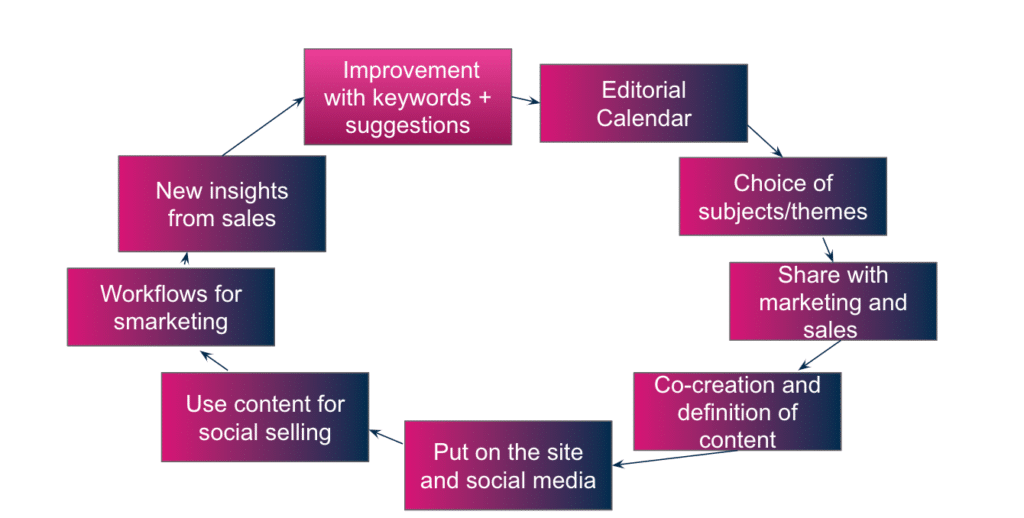If you keep an eye on common work practices, you might have come across the term “smarketing”. Intended to align the sales and marketing processes of a business, smarketing can both increase revenue and make teams more effective.
At Plezi, we’re totally convinced of the benefits of aligning the two, especially as part of implementing an inbound marketing strategy. So we’ve written this article to explain why sales and marketing alignment is important and the main steps you need to take in order to achieve this. At the end, we’ll even give you some practical things you can do to get the ball rolling.
1. Why is sales and marketing alignment important?
The aim of aligning sales and marketing is to integrate the work of two departments that have traditionally operated quite independently. Real cooperation between the two involves putting in place a new sales prospecting process based on sharing expertise and the distribution of content: inbound marketing (but not just that!).
Quite simply, aligning sales and marketing will make your business more effective. And an inbound marketing strategy helps align the two teams through the connections that it naturally makes between salespeople and marketers.
Integrating the actions of sales and marketing will enable you to:
- make sales prospecting easier;
- continuously fill the sales pipeline;
- create content for a specific target audience, based on how ready they are to buy and their decision-making level;
- ensure both teams use the same terms;
- provide greater visibility of everyone’s actions;
- ensure the smooth handover of leads and good lead management;
- promote cooperation between the two teams and help them achieve common goals;
- develop in-house expertise.
When you put it like this, who wouldn’t want to align their sales and marketing teams? So how do you get started?
2. Start by rethinking how your business is organized
The truth is that the process of aligning sales and marketing is an ongoing one that will require you to make continuous adjustments. But if you start with the fundamentals, you’ll gradually be able to put in place some good practices that will make it much easier to get the two departments to work closely together.
2.1 Carefully create your marketing funnel
Your marketing funnel or acquisition funnel sums up all of your interactions with prospects, from when they first visit your website to when they become customers. By identifying the different stages of your sales cycle and assigning each of the two departments with a role and objectives for each stage of the buyer’s journey, you will already have done most of the work.
Our marketing funnel, for example, includes the following stages:
- Visitor: an unidentified person visiting our website.
- Suspect / Lead: a person identified by marketing, but whose interest in our product or whose suitability hasn’t yet been confirmed.
- Prospect / MQL (Marketing Qualified Lead): the prospect is part of our target market and has shown an interest in our product.
- SQL (Sales Qualified Lead): the prospect has a project in mind, a budget, a timeframe for implementing a solution, and decision-makers have been identified.
- Opportunity: a quote has been sent and the company is in the process of deciding between several providers / products.
- Customer.
2.2 Define common terms
When you create your marketing funnel, you will put in place actions that will help structure the two teams. For example, by identifying the key stages which your prospects will go through, you will need to define some terms that both sales and marketing agree on.
At Plezi, we’ve paid particular attention to three specific elements:
- the buyer’s journey: the different theoretical stages in the thinking of a buyer persona, from their first visit to our website to their becoming a customer. When we started our inbound marketing strategy, we defined three distinct steps: Awareness, Consideration and Decision.
- the lead lifecycle: defined according to the actions they take, the information we have collected about them, and signs of their engagement with our content. This lets us identify both cold leads (to move further along the funnel) and hot leads (to be contacted). To do this, our sales and marketing teams established common definitions of the terms Lead, MQL (marketing qualified lead), SQL (sales qualified lead), and Customer when we created our first online forms.
- lead management: when we formalized our inbound marketing strategy, we created a visual representation of all the potential entry points for leads as well as the actions and points of contact involved throughout their lead lifecycle and defined the terms Source, Actions, Point of contact, and Time limit.
Using this information, you can define common terms to be used by sales and marketing in conjunction with an established buyer’s journey. Then, you can focus your efforts on the more practical aspects of how sales and marketing can work together.
2.3 Change team structures if needed
You might need to change the way in which your sales and marketing teams are structured depending on the different stages in your funnel and according to your conversion rates. Dividing your prospects’ different touchpoints with your company (e.g. visits, purchases, conversion) between the two departments will enable them to be linked by work processes and to use common tools.
The way teams are structured can obviously vary from company to company. Your preferences, corporate culture, and teams can all greatly affect how you go about doing so. At Plezi, we’ve added a qualification stage to our sales cycle and created a corresponding role for this – Inside Sales. Coming before normal sales representatives, the role of inside sales is to qualify marketing leads and to find new leads through prospecting. Just because we’re inbound marketers doesn’t mean we stop prospecting!
To make it easier for these inside sales representatives – and to make sure they’re not swamped by appointments with unqualified leads – we decided to send a questionnaire to prospects ahead of the appointment. The result? Their work is made easier because this questionnaire is full of valuable information. And when they contact a prospect, they can focus on what’s important.
2.4 Set common objectives
At Plezi, to help set quantitative targets that are shared by both teams, we’ve implemented a predictable revenue model. We first established what our conversion rates were for every stage of our acquisition funnel. To forecast growth, we started from the bottom of our funnel and set a target number of customers to reach. Then working back step by step, we identified the number of SQLs to generated by salespeople, then MQLs by marketing, etc.
By providing both teams with specific targets, they can then work together based on figures that give their relationship a solid foundation. An even better idea is to involve sales and marketing teams in preparing these figures. To start with, we recommend tracking three key indicators: the number of visitors, leads, and number of customers. Once your teams are familiar with these and ready for the next step, you can add other indicators.
3. Tips to successfully align sales and marketing
Now that we’ve looked at the main steps for aligning sales and marketing, here’s some practical things you can do to really get the ball rolling.
3.1 Give content creation a central role
Include salespeople in the process of creating content, the choice of content topics, and creating a brief. By doing so, you’ll not only make it easier for them to use this content as part of their sales process, but they’ll also be much more likely to become content ambassadors during the distribution stage. And receiving feedback from salespeople about prospects’ problems and concerns will enable you to create a virtuous circle for content.
3.2 Implement a Smarketing process
New processes and practices can have a big impact on your teams’ performance. At Plezi, we’ve put in place joint reporting, established regular meetings between sales and marketing, adapted scenarios to meet the needs of salespeople, and aligned remuneration for marketing with our overall objectives. All of these things are of value in the day-to-day work environment and have greatly helped support the process of aligning sales and marketing.
3.3 Sign an SLA (Service Level Agreement)
Having this formal agreement might seem unnecessary, but its real value lies in having sales and marketing meet to define its terms together. By agreeing together on what sales and marketing undertake to do in the course of their work, submitting it to everyone’s comments, and having both teams sign it, you create the basis of a sound working relationship between the two departments and a reference document to refer to in case of uncertainty or conflict.
3.4 Change your lead management system
Put in place a new system for managing leads. Set up a lead scoring system, integrate Plezi with your CRM, pass on information to sales, and have salespeople manage leads. Lead management is an essential and extremely useful process: the greater the number of entry points for leads, the greater the possibility there is for error.
By strengthening the process for managing leads, you’ll know exactly what stages, points of contact, and departments a lead will move through. This will let you later analyse where things could be improved to avoid losing leads.
Bonus tip: when you sign a new customer, be sure to go back up the entire chain of contacts a lead has had with your company to celebrate your success with all of the people who supported the customer as they moved through the funnel.
Don’t know quite where to start with aligning sales and marketing? Here again are the main steps:
- implement a new sales prospecting process;
- create your acquisition funnel;
- define common terms for use by both departments and ensure they have the same understanding of objectives;
above all, to save time and be more effective long term, spend the time now to align sales and marketing on a solid foundation.
To help you out, we’ve created a smarketing kit so you can follow how your sales and marketing are working together. You’ll be able to use it to see how much traffic do you need to get customers. How many leads a week do you need to pass on to sales reps to achieve your revenue goals. How to create acquisition tracking reports in minutes. How you can get realistic predictions from your marketing plan. Click below to download it.








